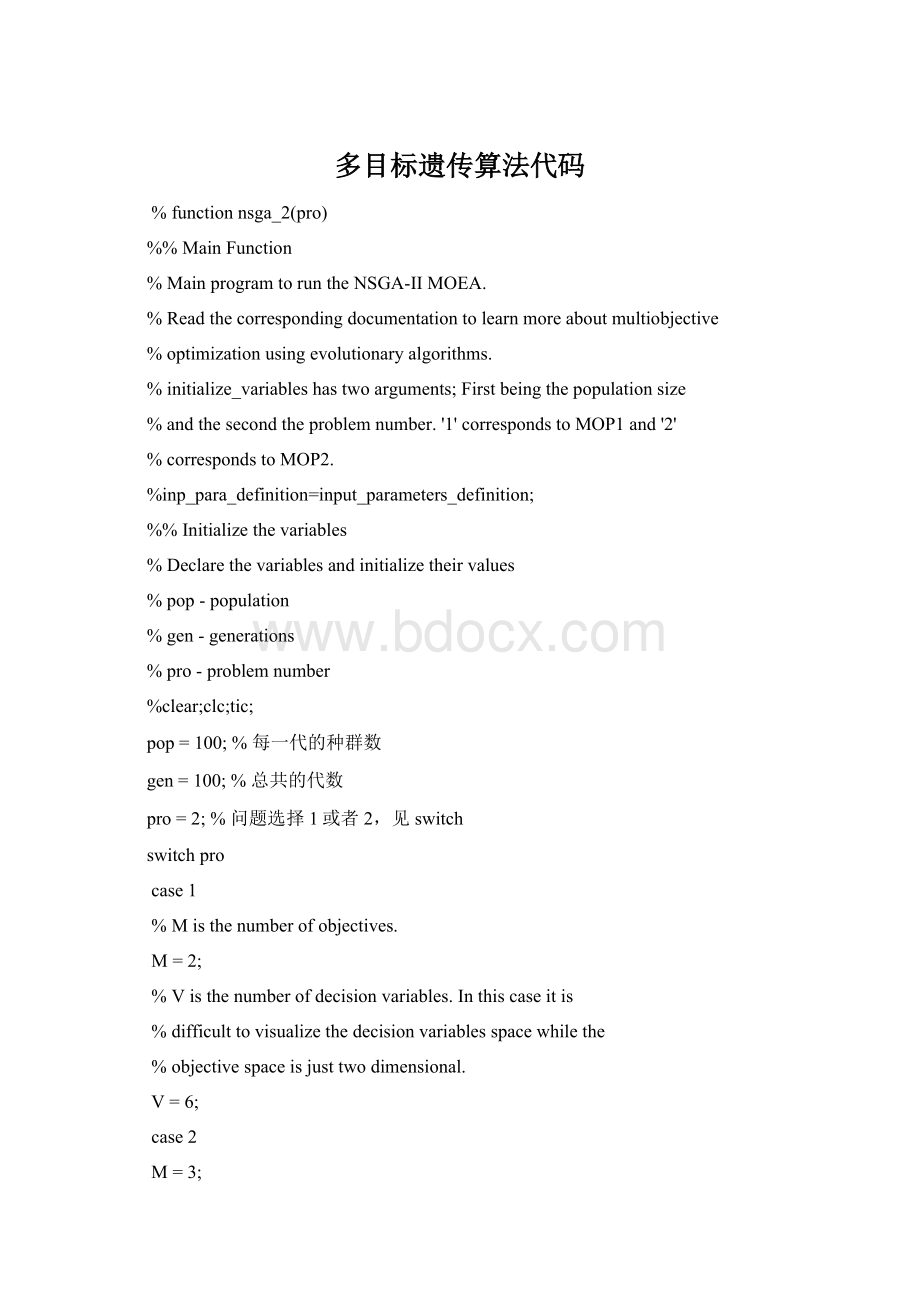多目标遗传算法代码.docx
《多目标遗传算法代码.docx》由会员分享,可在线阅读,更多相关《多目标遗传算法代码.docx(19页珍藏版)》请在冰豆网上搜索。

多目标遗传算法代码
%functionnsga_2(pro)
%%MainFunction
%MainprogramtoruntheNSGA-IIMOEA.
%Readthecorrespondingdocumentationtolearnmoreaboutmultiobjective
%optimizationusingevolutionaryalgorithms.
%initialize_variableshastwoarguments;Firstbeingthepopulationsize
%andthesecondtheproblemnumber.'1'correspondstoMOP1and'2'
%correspondstoMOP2.
%inp_para_definition=input_parameters_definition;
%%Initializethevariables
%Declarethevariablesandinitializetheirvalues
%pop-population
%gen-generations
%pro-problemnumber
%clear;clc;tic;
pop=100;%每一代的种群数
gen=100;%总共的代数
pro=2;%问题选择1或者2,见switch
switchpro
case1
%Misthenumberofobjectives.
M=2;
%Visthenumberofdecisionvariables.Inthiscaseitis
%difficulttovisualizethedecisionvariablesspacewhilethe
%objectivespaceisjusttwodimensional.
V=6;
case2
M=3;
V=12;
case3%case1和case2用来对整个算法进行常规验证,作为调试之用;case3为本工程所需;
M=2;%(outputparameters个数)
V=8;%(inputparameters个数)
K=10;
end
%Initializethepopulation
chromosome=initialize_variables(pop,pro);
%%Sorttheinitializedpopulation
%Sortthepopulationusingnon-domination-sort.Thisreturnstwocolumns
%foreachindividualwhicharetherankandthecrowdingdistance
%correspondingtotheirpositioninthefronttheybelong.真是牛X了。
chromosome=non_domination_sort_mod(chromosome,pro);
%%Starttheevolutionprocess
%Thefollowingareperformedineachgeneration
%Selecttheparents
%PerfromcrossoverandMutationoperator
%PerformSelection
fori=1:
gen
%Selecttheparents
%Parentsareselectedforreproductiontogenerateoffspring.The
%originalNSGA-IIusesabinarytournamentselectionbasedonthe
%crowded-comparisionoperator.Theargumentsare
%pool-sizeofthematingpool.Itiscommontohavethistobehalfthe
%populationsize.
%tour-Tournamentsize.OriginalNSGA-IIusesabinarytournament
%selection,buttoseetheeffectoftournamentsizethisiskept
%arbitary,tobechoosenbytheuser.
pool=round(pop/2);
tour=2;
%下面进行二人锦标赛配对,新的群体规模是原来群体的一半
parent_chromosome=tournament_selection(chromosome,pool,tour);
%PerfromcrossoverandMutationoperator
%TheoriginalNSGA-IIalgorithmusesSimulatedBinaryCrossover(SBX)and
%Polynomialcrossover.Crossoverprobabilitypc=0.9andmutation
%probabilityispm=1/n,wherenisthenumberofdecisionvariables.
%Bothreal-codedGAandbinary-codedGAareimplementedintheoriginal
%algorithm,whileinthisprogramonlythereal-codedGAisconsidered.
%Thedistributionindeicesforcrossoverandmutationoperatorsasmu=20
%andmum=20respectively.
mu=20;
mum=20;
%针对对象是上一步产生的新的个体parent_chromosome
%对parent_chromosome每次操作以较大的概率进行交叉(产生两个新的候选人),或者较小的概率变异(一个新的候选人)操作,这样
%就会产生较多的新个体
offspring_chromosome=genetic_operator(parent_chromosome,pro,mu,mum);
%Intermediatepopulation
%Intermediatepopulationisthecombinedpopulationofparentsand
%offspringsofthecurrentgeneration.Thepopulationsizeisalmost1and
%halftimestheinitialpopulation.
[main_pop,temp]=size(chromosome);
[offspring_pop,temp]=size(offspring_chromosome);
intermediate_chromosome(1:
main_pop,:
)=chromosome;
intermediate_chromosome(main_pop+1:
main_pop+offspring_pop,1:
M+V)=offspring_chromosome;
%intermediate_chromosome=inter_chromo(chromosome,offspring_chromosome,pro);
%Non-domination-sortofintermediatepopulation
%Theintermediatepopulationissortedagainbasedonnon-dominationsort
%beforethereplacementoperatorisperformedontheintermediate
%population.
intermediate_chromosome=...
non_domination_sort_mod(intermediate_chromosome,pro);
%PerformSelection
%Oncetheintermediatepopulationissortedonlythebestsolutionis
%selectedbasedonitrankandcrowdingdistance.Eachfrontisfilledin
%ascendingorderuntiltheadditionofpopulationsizeisreached.The
%lastfrontisincludedinthepopulationbasedontheindividualswith
%leastcrowdingdistance
chromosome=replace_chromosome(intermediate_chromosome,pro,pop);
if~mod(i,10)
fprintf('%d\n',i);
end
end
%%Result
%SavetheresultinASCIItextformat.
savesolution.txtchromosome-ASCII
%%Visualize
%Thefollowingisusedtovisualizetheresultforthegivenproblem.
switchpro
case1
plot(chromosome(:
V+1),chromosome(:
V+2),'y+');
title('MOP1usingNSGA-II');
xlabel('f(x_1)');
ylabel('f(x_2)');
case2
plot3(chromosome(:
V+1),chromosome(:
V+2),chromosome(:
V+3),'*');
title('MOP2usingNSGA-II');
xlabel('f(x_1)');
ylabel('f(x_2)');
zlabel('f(x_3)');
end
%disp('runtimeis:
')
%toc;
%%%%%%%%%%%%%%%%%%%%%%%%%%%%%%%%%%%%%%%%%%%%%%%%%%%%%%
functionf=initialize_variables(N,problem)
%functionf=initialize_variables(N,problem)
%N-Populationsize
%problem-takesintegervalues1and2where,
%'1'forMOP1
%'2'forMOP2
%
%ThisfunctioninitializesthepopulationwithNindividualsandeach
%individualhavingMdecisionvariablesbasedontheselectedproblem.
%M=6forproblemMOP1andM=12forproblemMOP2.Theobjectivespace
%forMOP1is2dimensionalwhileforMOP2is3dimensional.
%BoththeMOP'shas0to1asitsrangeforallthedecisionvariables.
min=0;
max=1;
switchproblem
case1
M=6;
K=8;%k=决策变量(M=6)+目标变量(K-M=2)=8
case2
M=12;
K=15;
case3%case1和case2用来对整个算法进行常规验证,作为调试之用;case3为本工程所需;
M=8;%(inputparameters个数)
K=10;
end
fori=1:
N
%Initializethedecisionvariables
forj=1:
M
f(i,j)=rand
(1);%i.ef(i,j)=min+(max-min)*rand
(1);
end
%Evaluatetheobjectivefunction
f(i,M+1:
K)=evaluate_objective(f(i,:
),problem);
end
%%%%%%%%%%%%%%%%%%%%%%%%%%%%%%%%%%%%%%%%%%%%%%%%%%%%%
functionf=evaluate_objective(x,problem)
%Functiontoevaluatetheobjectivefunctionsforthegiveninputvector
%x.xhasthedecisionvariables
switchproblem
case1
f=[];
%%Objectivefunctionone
f
(1)=1-exp(-4*x
(1))*(sin(6*pi*x
(1)))^6;
sum=0;
fori=2:
6
sum=sum+x(i)/4;
end
%%Intermediatefunction
g_x=1+9*(sum)^(0.25);
%%Objectivefunctionone
f
(2)=g_x*(1-((f
(1))/(g_x))^2);
case2
f=[];
%%Intermediatefunction
g_x=0;
fori=3:
12
g_x=g_x+(x(i)-0.5)^2;
end
%%Objectivefunctionone
f
(1)=(1+g_x)*cos(0.5*pi*x
(1))*cos(0.5*pi*x
(2));
%%Objectivefunctiontwo
f
(2)=(1+g_x)*cos(0.5*pi*x
(1))*sin(0.5*pi*x
(2));
%%Objectivefunctionthree
f(3)=(1+g_x)*sin(0.5*pi*x
(1));
case3
f=[];
%%Objectivefunctionone
f
(1)=0;
%%Objectivefunctionone
f
(2)=0;
end
%%%%%%%%%%%%%%%%%%%%%%%%%%%%%%%%%%%%%%%%%%%%%%%%%%%
%%Non-DonimationSort%按照目标函数最小了好
%Thisfunctionsortthecurrentpopultionbasedonnon-domination.Allthe
%individualsinthefirstfrontaregivenarankof1,thesecondfront
%individualsareassignedrank2andsoon.Afterassigningtherankthe
%crowdingineachfrontiscalculated.
functionf=non_domination_sort_mod(x,problem)
[N,M]=size(x);
switchproblem
case1
M=2;
V=6;
case2
M=3;
V=12;
case3%case1和case2用来对整个算法进行常规验证,作为调试之用;case3为本工程所需;
M=2;%(outputparameters个数)
V=8;%(inputparameters个数)
K=10;
end
front=1;
%Thereisnothingtothisassignment,usedonlytomanipulateeasilyin
%MATLAB.
F(front).f=[];
individual=[];
fori=1:
N
%Numberofindividualsthatdominatethisindividual支配i的解的个数
individual(i).n=0;
%Individualswhichthisindividualdominate被i支配的解
individual(i).p=[];
forj=1:
N
dom_less=0;
dom_equal=0;
dom_more=0;
fork=1:
M
if(x(i,V+k)dom_less=dom_less+1;
elseif(x(i,V+k)==x(j,V+k))
dom_equal=dom_equal+1;
else
dom_more=dom_more+1;
end
end
%这里只要考虑到求取得是函数的最小值就可以了,此时支配的概念就会变为谁的函数值小,谁去支配别的解
%——————————————————————
ifdom_less==0&dom_equal~=M%举个例子,其中i=a,b;j=c,d;如果i中的a,b全部大于
individual(i).n=individual(i).n+1;%或者部分大于j中的c,d(但没有小于的情况),则称为i优于j,
elseifdom_more==0&dom_equal~=M%当i优于j的时候,则此时把individual(i)_n加1
individual(i).p=[individual(i).pj];%如果i中的a,b全部小于或者部分小于j中的c,d(但没有大于的情况),则
end%则称为j优于i,则把此时的j放入individual(i)_P中;
end%总之,就是说两个目标变量必须全部大于或者全部小于才能对individual有效。
ifindividual(i).n==0%如果没有劣于i的话,即F(front).f存放的都是差的解.
x(i,M+V+1)=1;
F(front).f=[F(front).fi];
end
end
%Findthesubsequentfronts
while~isempty(F(front).f)
Q=[];
fori=1:
length(F(front).f)%i表示最优解
if~isempty(individual(F(front).f(i)).p)
forj=1:
length(individual(F(front).f(i)).p)%被前端解i所支配的解得集合,这个集合由j构成,
individual(individual(F(front).f(i)).p(j)).n=individual(individual(F(front).f(i)).p(j)).n-1;
ifindividual(individual(F(front).f(i)).p(j)).n==0
x(individual(F(front).f(i)).p(j),M+V+1)=front+1;
Q=[Qindividual(F(front).f(i)).p(j)];
end
end
end
end
front=front+1;
F(front).f=Q;
end
%functionsort:
sort(x_sequence)===>>returnaincreasingorerdatasequence
[temp,index_of_fronts]=sort(x(:
M+V+1));
fori=1:
length(index_of_fronts)
sorted_based_on_front(i,:
)=x(index_of_fronts(i),:
);%对解(染色体)进行排序,按照front分层
end
%到这里分层结束,下面就是计算距离了
current_index=0;
%Findthecrowdingdistanceforeachindividualineachfront
%,计算不同层的拥挤距离是没有意义的
forfront=1:
(length(F)-1)
objective=[];
distance=0;
y=[];
previous_index=current_index+1;
fori=1:
length(F(front).f)
y(i,:
)=sorted_based_on_front(current_index+i,:
);
end
current_index=current_index+i;
%Sorteachindividualbasedontheobjective
sorted_based_on_objective=[];
fori=1:
M
[sorted_based_on_objective,index_of_objectives]=sort(y(:
V+i));
sorted_